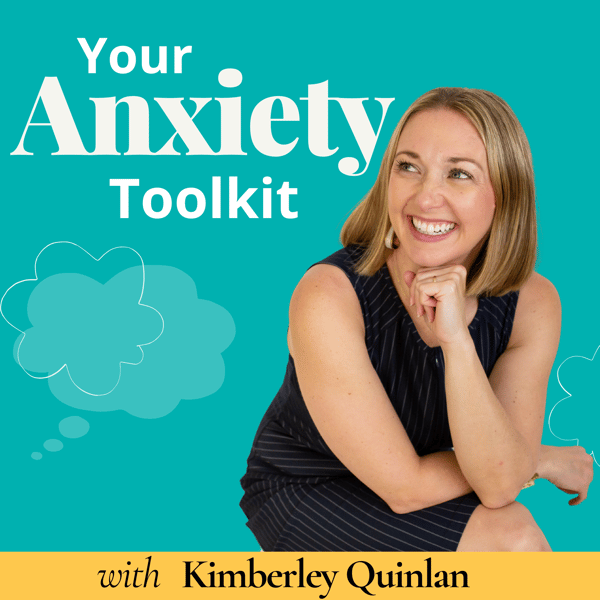Ep. 115: Finding Your Compassionate Voice
Your Anxiety Toolkit - Anxiety & OCD Strategies for Everyday
Kimberley Quinlan, LMFT | Anxiety & OCD Specialist
4.9 • 802 Ratings
🗓️ 23 August 2019
⏱️ 19 minutes
🧾️ Download transcript
Summary

Welcome back to another episode of Your Anxiety Toolkit. Today I was reflecting on what you might need to hear and it dawned on me that you might need a solid dose of compassion. So, today we are talking about finding your compassionate voice. In this podcast, I will lead you through a “Finding your compassionate voice” meditation, created originally by Kristin Neff and Christopher Germer. The script is below, but please note that I did change a few components to match the style of my voice and my ideas for what you needed to hear.
Finding your compassionate voice involves us bringing what we need to hear to our awareness. Examples of finding your compassionate voice might sound like:
“I love you”
“I am here for you”
“You are enough”
“You are loved”
“Everything is going to be ok”
Finding your compassionate voice is an exercise or tool that might be able to offer you a skill to increase self-compassion, self-kindness, and self-respect.
Finding your Compassionate Voice Meditation
Please find a posture in which your body is comfortable and will feel supported for the length of the meditation.
Then let your eyes gently close, partially or fully.
Taking a few slow, easy breaths, releasing any unnecessary tension in your body.
• If you’d like, placing a hand over your heart or another soothing place as a reminder that we’re bringing not only awareness but affectionate awareness to our breathing and to ourselves. You can leave your hand there or let it rest at any time.
• Now beginning to notice your breathing in your body, feeling your body breathe in and feeling your body breathe out. Now releasing the focus on your breathing, allowing the breath to slip into the background of your awareness, begin to offer yourself words or phrases that are meaningful to you. Whisper these words into your own ear.
• Just letting your body breathe you. There is nothing you need to do.
• Perhaps noticing how your body is nourished on the in-breath and relaxes with the out-breath.
• Now noticing the rhythm of your breathing, flowing in and flowing out. (pause) Taking some time to feel the natural rhythm of your breathing.
• Feeling your whole body subtly moving with the breath, like the movement of the sea.
• Your mind will naturally wander like a curious child or a little puppy. When that happens, just gently returning to the rhythm of your breathing. This is mindfulness.
• Allowing your whole body to be gently rocked and caressed – internally caressed - by your breathing.
• If you like, even giving yourself over to your breathing, letting your breathing be all there is. Becoming the breath.
• Just breathing. Being breathing.
• And now, gently releasing your attention to the breath, sitting quietly in your own experience, and allowing yourself to feel whatever you’re feeling and to be just as you are.
• Slowly and gently open your eyes.
Transcript
Click on a timestamp to play from that location
| 0:00.0 | This is Your Anxiety Toolkit episode number 115. |
| 0:10.1 | Welcome to Your Anxiety Toolkit. I'm your host, Kimberly Quinlan. This podcast is fueled by three |
| 0:17.1 | main goals. The first goal is to provide you with some extra tools |
| 0:21.3 | to help you manage your anxiety. |
| 0:23.7 | Second goal, to inspire you. |
| 0:26.1 | Anxiety doesn't get to decide how you live your life. |
| 0:29.5 | And number three, and I leave the best for last, |
| 0:32.4 | is to provide you with one big, fat virtual hug |
| 0:36.8 | because experiencing anxiety ain't easy. |
| 0:39.3 | If that sounds good to you, let's go. |
| 0:46.0 | Well, welcome back. |
| 0:47.6 | I'm so thrilled to have you here with me today. |
| 0:51.9 | I really, really do honor that you are taking your precious time and spending it |
| 0:56.6 | with me. So thank you. Today, I was thinking as I was dropping my daughter off from her very |
| 1:04.4 | first day of school for another school year. And I was wondering, maybe what do you guys need? I was thinking about |
| 1:13.2 | what is it that you need? And it got me to thinking that maybe it's not what I think you need. |
| 1:18.6 | It might be a time for you to reflect on what you need. And this is a core part of or component of self-compassion. So I basically made the decision for |
| 1:34.2 | today's podcast based on this contemplation of what you guys might be needing right now. |
| 1:41.1 | And my guess is it's a little bit of extra self-compassion. It always goes a long way |
| 1:47.0 | and we can never have too much of it. So here I am today bringing you what I think you need |
| 1:53.2 | and offering an opportunity for you to connect with what it is that you need. I'm going to go back to the format in which I originally used when I started this podcast |
| 2:08.1 | was to do more meditations, more led meditations. |
... |
Please login to see the full transcript.
Disclaimer: The podcast and artwork embedded on this page are from Kimberley Quinlan, LMFT | Anxiety & OCD Specialist, and are the property of its owner and not affiliated with or endorsed by Tapesearch.
Generated transcripts are the property of Kimberley Quinlan, LMFT | Anxiety & OCD Specialist and are distributed freely under the Fair Use doctrine. Transcripts generated by Tapesearch are not guaranteed to be accurate.
Copyright © Tapesearch 2025.

